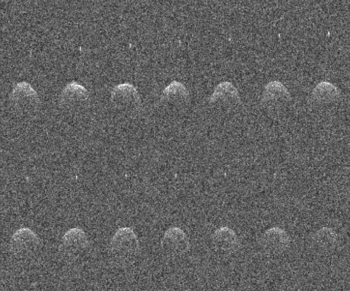Dimorphos: Difference between revisions
Jump to navigation
Jump to search

Mark Widmer (talk | contribs) (→References: Added ESA reference.) |
Pat Palmer (talk | contribs) (adding another detail to the opener) |
||
| (14 intermediate revisions by 2 users not shown) | |||
| Line 1: | Line 1: | ||
{{subpages}} | {{subpages}} | ||
{{Image|Didymos-Arecibo-radar-images.png|right|350px|Fourteen sequential Arecibo radar images of the near-Earth asteroid (65803) Didymos and its moonlet Dimorphos, taken on 23, 24 and 26 November 2003.}} | |||
'''Dimorphos''' is satellite [[asteroid]] of the larger asteroid [[Didymos]] within the [[solar system]]. The two asteroids comprise a binary asteroid system within the [[solar system]], with Dimorphos accounting for roughly 1% of the mass of the system. Dimorphos is roughly 160 meters (520 feet) in diameter. It orbits Didymos every 11.9 hours, with an orbital radius of approximately 1.2 kilometers (0.7 miles). As such, it has an orbital speed of about 17 centimeters per second relative to Didymos.<ref name=solarsys_nasa/><ref name=asteroid_esa/><ref name=johnston/> | |||
The binary system of Didymos' and its satellite have an orbital location that varies between Earth orbit and just outside Mars' orbit. | |||
== | ==References== | ||
{{Reflist|refs= | |||
== | <ref name=solarsys_nasa> | ||
{{cite news | |||
| url = https://solarsystem.nasa.gov/asteroids-comets-and-meteors/asteroids/didymos/in-depth/ | |||
| title = Didymos via NASA Science SOLAR SYSTEM EXPLORATION | |||
| work = | |||
| author = | |||
| date = 6-12-2022 | |||
| page = | |||
| location = | |||
| isbn = | |||
| language = | |||
| trans-title = | |||
| archiveurl = | |||
| archivedate = | |||
| accessdate = 6-12-2022 | |||
| url-status = live | |||
| quote = | |||
}} | |||
</ref> | |||
<ref name=asteroid_esa> | |||
{{cite news | |||
| url = https://www.esa.int/Safety_Security/Hera/Target_asteroid2 | |||
| title = The European Space Agency: Target asteroid of the Hera mission (Didymos) | |||
| work = | |||
| author = | |||
| date = 6-12-2022 | |||
| page = | |||
| location = | |||
| isbn = | |||
| language = | |||
| trans-title = | |||
| archiveurl = | |||
| archivedate = | |||
| accessdate = 6-12-2022 | |||
| url-status = live | |||
| quote = | |||
}} | |||
</ref> | |||
<ref name=johnston> | |||
{{cite news | |||
| url = http://www.johnstonsarchive.net/astro/astmoons/am-65803.html | |||
| title = Asteroids with Satellites Database--Johnston's Archive: (65803) Didymos and Dimorphos | |||
| work = | |||
| author = | |||
| date = 6-12-2022 | |||
| page = | |||
| location = | |||
| isbn = | |||
| language = | |||
| trans-title = | |||
| archiveurl = | |||
| archivedate = | |||
| accessdate = 6-12-2022 | |||
| url-status = live | |||
| quote = | |||
}} | |||
</ref> | |||
}} | |||
Latest revision as of 14:07, 4 May 2023
Dimorphos is satellite asteroid of the larger asteroid Didymos within the solar system. The two asteroids comprise a binary asteroid system within the solar system, with Dimorphos accounting for roughly 1% of the mass of the system. Dimorphos is roughly 160 meters (520 feet) in diameter. It orbits Didymos every 11.9 hours, with an orbital radius of approximately 1.2 kilometers (0.7 miles). As such, it has an orbital speed of about 17 centimeters per second relative to Didymos.[1][2][3]
The binary system of Didymos' and its satellite have an orbital location that varies between Earth orbit and just outside Mars' orbit.
References
- ↑ Didymos via NASA Science SOLAR SYSTEM EXPLORATION, 6-12-2022. Retrieved on 6-12-2022.
- ↑ The European Space Agency: Target asteroid of the Hera mission (Didymos), 6-12-2022. Retrieved on 6-12-2022.
- ↑ Asteroids with Satellites Database--Johnston's Archive: (65803) Didymos and Dimorphos, 6-12-2022. Retrieved on 6-12-2022.
